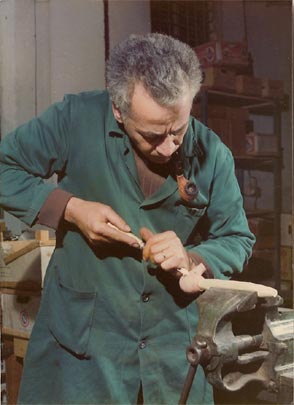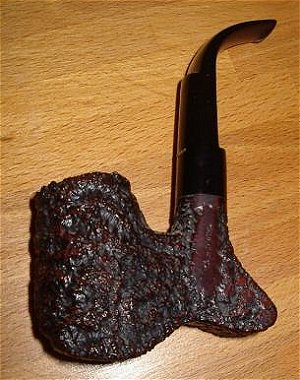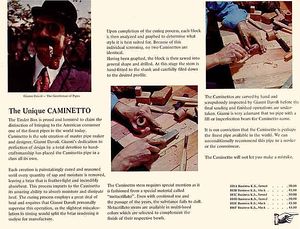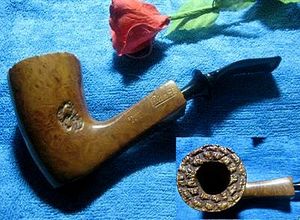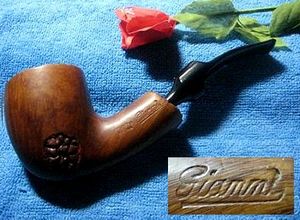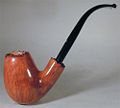Caminetto: Difference between revisions
No edit summary |
No edit summary |
||
| Line 1: | Line 1: | ||
[[Image:Caminetto.jpg|left|thumb]] | [[Image:Caminetto.jpg|left|thumb]] | ||
Caminetto's history | Caminetto's history started in 1959 when '''Guiseppe Ascorti''', from Cucciago, and known to his friends as "Peppino", was hired by '''Carlo Scotti''' to work at '''[[Castello]]''', located in nearby Cantu. Since it's foundation in 1947 Castello had contributed substantially to re-gained glory for Italian pipemaking. Talent and assiduity soon made Ascorti one of Scotti's most notable pipemakers. A man he counted on for the future. But Ascorti had his own far reaching plan: he wanted to work as a self-employed pipemaker! After his wife Paola had taken over her parent's small greengrocery in the early 60s this plan became more concrete. The additional income from the shop enabled him to buy tools and machines little by little to furnish his own workshop. By the end of 1968 he was ready and left Castello. Ascorti also persuaded the young and highly talented pipemaker '''Luigi [[Radice]]''' (born 1939), who was also his next door neighbor in Cucciago, to join him. Carlo Scotti, whom is known as a perfect gentleman, is reported to have spoken unreservedly about this development. | ||
Ascorti & Radice started to manufacture pipes | Ascorti & Radice started to manufacture pipes on their own. One of the first who agreed to market their pipes was '''Gianni Davoli''', proprietor of a tobacco shop in Milan. The situation was perfect--two pipemakers in search of a distributor, and a pipe merchant in search of a mainstay brand to market. Davoli - via friends and relations in the States - had made florishing contacts with US pipe wholesalers and traders. He shipped some pipes across the pond for inspection and received excellent feedback for the very high quality of the pipes. So he shortly after offered to be the sole distributor worldwide and Ascorti & Radice happily accepted. | ||
[[Image:Caminetto_27.JPG|right|thumb|Impressive old production Business with hoof]] | [[Image:Caminetto_27.JPG|right|thumb|Impressive old production Business with hoof]] | ||
Then came the legendary evening Ascorti, Radice and Davoli gathered around the fireplace after a hard day's work enjoying their pipes, a glass of wine and humorous conversation. Davoli is said to be the one who associated the pipes with the fireplace or chimney which is "camino" in Italian. Hence "Caminetto", the diminutive (smaller) singular version of camino, was coined as the brand's name. And Ascorti, Radice and Davoli later became famous as "I tre Camini" - the three chimneys. Maybe, they had more than one glass of wine each, but it's not | Then came the legendary evening Ascorti, Radice and Davoli gathered around the fireplace after a hard day's work enjoying their pipes, a glass of wine, and humorous conversation. Davoli is said to be the one who associated the pipes with the fireplace or chimney, which is "camino" in Italian. Hence "Caminetto", the diminutive (smaller) singular version of camino, was coined as the brand's name. And Ascorti, Radice and Davoli later became famous as "I tre Camini" - the three chimneys. Maybe, they had more than one glass of wine each, but it's not certain whether the distinctive mustache logo on the stem and the Caminetto slogan "La Pipa del Baffo" - "the pipe with the mustache" - was created the same night. In fact, Ascorti and Radice both wore impressively large mustaches and a pharmacist in the neighborhood had been kidding on them about that. (Davoli, for reasons of corporate identity, later wore a big mustache, too.) | ||
Now Davoli concentrated on marketing the Caminetto brand in the United States. His strategy was as simple as brilliant. There was a remarkable Castello hype at that time. | Now Davoli concentrated on marketing the Caminetto brand in the United States. His strategy was as simple as brilliant. There was a remarkable Castello hype at that time. Castello pipes were highly sought after but hard to get due to limited production. Davoli filled the gap, promoting the Caminetto to be absolutely equal to the Castello in terms of quality, but asking only half the price. And best of all: the Caminettos were consignable! The Tinder Box International was put under contract, with successful nationwide distribution. The success was overwhelming - far beyond any expectation, with the rusticated Business line becoming the most popular. | ||
[[Image:Caminetto_05.jpg|left|thumb]] | [[Image:Caminetto_05.jpg|left|thumb]] | ||
Ironically enough, the increasing demand drove Ascorti and Radice to the limits of their production | Ironically enough, the increasing demand soon drove Ascorti and Radice to the limits of their production. The brand had been introduced successfully in Germany, and in Italy to some extent. By the end of 1970 more hands were needed. Even Ascorti's elder son, Roberto (born 1958; and the current owner) helped with stamping and shipping the pipes when he was yet a schoolboy. The most important employee is '''Cesare Vigano''', who has worked for Caminetto / Ascorti for more than thirty years. To bring about more stability and higher production, Davoli invested a considerable amount of money in modern pipemaking machinery, and in doing so went from distributor to co-owner of Caminetto. By 1973 he held the vast majority of the company's capital. | ||
The boom, especially in the USA, continued strongly. Production increasing steadily 3,000, 5,000, 7,000 pipes per year were made placing Caminetto at the top of the US sales in their market segment. The | The boom, especially in the USA, continued strongly. Production increasing steadily as 3,000, 5,000, and then 7,000 pipes per year were made, placing Caminetto at the top of the US sales in their market segment. The 1974 Tinderbox catalog celebrates Gianni Davoli as "master pipe maker and designer" and "the sole creator of the Caminetto" without a single mention of Ascorti or Radice! | ||
[[Image:Gianni_1.jpg|left|thumb]][[Image:Gianni_2.jpg|right|thumb]] | [[Image:Gianni_1.jpg|left|thumb]][[Image:Gianni_2.jpg|right|thumb]] | ||
btw. In addition Davoli sold a private label brand by Ascorti / Radice named '''Gianni''' for a couple of years in Italy. | btw. In addition to Caminitto, Davoli sold a private label brand by Ascorti / Radice named '''Gianni''' for a couple of years in Italy. | ||
Caminetto prospered | Caminetto prospered throughout the 70s. Everyone was hard at work, sales continued to increase, but soon there after, disagreements occurred among the three principles, marking the begin of the end. | ||
First Luigi Radice became increasingly discontent with the factory like production. Pipes were made by standard shape numbers and there was no longer room for his own creative pipemaking and personal development. He was also afraid that the increased production would eventually lead to a reduction in quality. Radice started quarreling with Ascorti about the future course of Caminetto, and they were unable to find a solution. Radice, being an employed pipemaker rather than a partner, could not assert himself. | |||
Ascorti shared Radice's concerns about maintaining the quality in the face of the higher production, but Davoli had gained almost total control by this time, and insisted on the higher production. | |||
- | The next controversy was regarding Roberto. The young man had visited a school of arts and also completed his service in the army. Roberto did not want to attend an university and instead started helping in the workshop with pipe repairs, and making his first few pipes. His father wanted to hire him in as a full-time pipemaker, but Davoli refused, being afraid to loose influence to the potentially strong alliance between father and son. | ||
The situation worsened in 1979. The foreseen quality issues occurred--there were complaints from the US. And there is some indication that Carlo Scotti considered legal actions, asserting that Caminetto had copied some of Castello's successful shapes too exactly. At this point Ascorti wanted to sever ties with Davoli, but Davoli was able to assert himself and maintained control. | |||
I tre Camini disbanded in December of 1979 when Luigi Radice left, without prospects, knowing not where or how he would continue as a pipemaker. A clear indication that he had very strong feelings as to his future with Caminetto. | |||
Ascorti | Ascorti vs. Davoli continued for a few more months. The Ascorti family offered to buy the brand, but they couldn't afford it at the time. So Guiseppe Ascorti hastily equipped a new workshop and then he left company which was essentially his own. But the complete crew whom he had trained in the old Caminetto workshop followed him. And thus they were able to re-start making pipes within a few weeks in 1980. For three months they sold pipes under the name '''Sergio'''. Only 800 to 1,000 Sergio pipes were released. Then Giuseppe Ascorti and his son Roberto founded a new company under their own last name. - For the further history see '''[[Ascorti]]'''! | ||
Upon leaving Caminetto, Luigi Radice went through huge difficulties, but through the 1980s he also managed to establish himself as independent pipemaker. | |||
Luigi Radice went through huge difficulties, but | |||
Gianni Davoli, last chimney standing, stayed behind, now owning a pipe workshop without any pipemakers. Strange enough, the old Caminetto workshop caught fire shortly afterward and burned down to ashes. | |||
<gallery> | <gallery> | ||
Revision as of 03:15, 27 March 2008
Caminetto's history started in 1959 when Guiseppe Ascorti, from Cucciago, and known to his friends as "Peppino", was hired by Carlo Scotti to work at Castello, located in nearby Cantu. Since it's foundation in 1947 Castello had contributed substantially to re-gained glory for Italian pipemaking. Talent and assiduity soon made Ascorti one of Scotti's most notable pipemakers. A man he counted on for the future. But Ascorti had his own far reaching plan: he wanted to work as a self-employed pipemaker! After his wife Paola had taken over her parent's small greengrocery in the early 60s this plan became more concrete. The additional income from the shop enabled him to buy tools and machines little by little to furnish his own workshop. By the end of 1968 he was ready and left Castello. Ascorti also persuaded the young and highly talented pipemaker Luigi Radice (born 1939), who was also his next door neighbor in Cucciago, to join him. Carlo Scotti, whom is known as a perfect gentleman, is reported to have spoken unreservedly about this development.
Ascorti & Radice started to manufacture pipes on their own. One of the first who agreed to market their pipes was Gianni Davoli, proprietor of a tobacco shop in Milan. The situation was perfect--two pipemakers in search of a distributor, and a pipe merchant in search of a mainstay brand to market. Davoli - via friends and relations in the States - had made florishing contacts with US pipe wholesalers and traders. He shipped some pipes across the pond for inspection and received excellent feedback for the very high quality of the pipes. So he shortly after offered to be the sole distributor worldwide and Ascorti & Radice happily accepted.
Then came the legendary evening Ascorti, Radice and Davoli gathered around the fireplace after a hard day's work enjoying their pipes, a glass of wine, and humorous conversation. Davoli is said to be the one who associated the pipes with the fireplace or chimney, which is "camino" in Italian. Hence "Caminetto", the diminutive (smaller) singular version of camino, was coined as the brand's name. And Ascorti, Radice and Davoli later became famous as "I tre Camini" - the three chimneys. Maybe, they had more than one glass of wine each, but it's not certain whether the distinctive mustache logo on the stem and the Caminetto slogan "La Pipa del Baffo" - "the pipe with the mustache" - was created the same night. In fact, Ascorti and Radice both wore impressively large mustaches and a pharmacist in the neighborhood had been kidding on them about that. (Davoli, for reasons of corporate identity, later wore a big mustache, too.)
Now Davoli concentrated on marketing the Caminetto brand in the United States. His strategy was as simple as brilliant. There was a remarkable Castello hype at that time. Castello pipes were highly sought after but hard to get due to limited production. Davoli filled the gap, promoting the Caminetto to be absolutely equal to the Castello in terms of quality, but asking only half the price. And best of all: the Caminettos were consignable! The Tinder Box International was put under contract, with successful nationwide distribution. The success was overwhelming - far beyond any expectation, with the rusticated Business line becoming the most popular.
Ironically enough, the increasing demand soon drove Ascorti and Radice to the limits of their production. The brand had been introduced successfully in Germany, and in Italy to some extent. By the end of 1970 more hands were needed. Even Ascorti's elder son, Roberto (born 1958; and the current owner) helped with stamping and shipping the pipes when he was yet a schoolboy. The most important employee is Cesare Vigano, who has worked for Caminetto / Ascorti for more than thirty years. To bring about more stability and higher production, Davoli invested a considerable amount of money in modern pipemaking machinery, and in doing so went from distributor to co-owner of Caminetto. By 1973 he held the vast majority of the company's capital.
The boom, especially in the USA, continued strongly. Production increasing steadily as 3,000, 5,000, and then 7,000 pipes per year were made, placing Caminetto at the top of the US sales in their market segment. The 1974 Tinderbox catalog celebrates Gianni Davoli as "master pipe maker and designer" and "the sole creator of the Caminetto" without a single mention of Ascorti or Radice!
btw. In addition to Caminitto, Davoli sold a private label brand by Ascorti / Radice named Gianni for a couple of years in Italy.
Caminetto prospered throughout the 70s. Everyone was hard at work, sales continued to increase, but soon there after, disagreements occurred among the three principles, marking the begin of the end.
First Luigi Radice became increasingly discontent with the factory like production. Pipes were made by standard shape numbers and there was no longer room for his own creative pipemaking and personal development. He was also afraid that the increased production would eventually lead to a reduction in quality. Radice started quarreling with Ascorti about the future course of Caminetto, and they were unable to find a solution. Radice, being an employed pipemaker rather than a partner, could not assert himself.
Ascorti shared Radice's concerns about maintaining the quality in the face of the higher production, but Davoli had gained almost total control by this time, and insisted on the higher production.
The next controversy was regarding Roberto. The young man had visited a school of arts and also completed his service in the army. Roberto did not want to attend an university and instead started helping in the workshop with pipe repairs, and making his first few pipes. His father wanted to hire him in as a full-time pipemaker, but Davoli refused, being afraid to loose influence to the potentially strong alliance between father and son.
The situation worsened in 1979. The foreseen quality issues occurred--there were complaints from the US. And there is some indication that Carlo Scotti considered legal actions, asserting that Caminetto had copied some of Castello's successful shapes too exactly. At this point Ascorti wanted to sever ties with Davoli, but Davoli was able to assert himself and maintained control.
I tre Camini disbanded in December of 1979 when Luigi Radice left, without prospects, knowing not where or how he would continue as a pipemaker. A clear indication that he had very strong feelings as to his future with Caminetto.
Ascorti vs. Davoli continued for a few more months. The Ascorti family offered to buy the brand, but they couldn't afford it at the time. So Guiseppe Ascorti hastily equipped a new workshop and then he left company which was essentially his own. But the complete crew whom he had trained in the old Caminetto workshop followed him. And thus they were able to re-start making pipes within a few weeks in 1980. For three months they sold pipes under the name Sergio. Only 800 to 1,000 Sergio pipes were released. Then Giuseppe Ascorti and his son Roberto founded a new company under their own last name. - For the further history see Ascorti!
Upon leaving Caminetto, Luigi Radice went through huge difficulties, but through the 1980s he also managed to establish himself as independent pipemaker.
Gianni Davoli, last chimney standing, stayed behind, now owning a pipe workshop without any pipemakers. Strange enough, the old Caminetto workshop caught fire shortly afterward and burned down to ashes.
Caminetto c/o Ascorti Fap (S.N.C.) - Roberto Ascorti - Via Alessandro Volta 14/B 22060 Cucciago Italy Tel.: (+39) 031 787176
